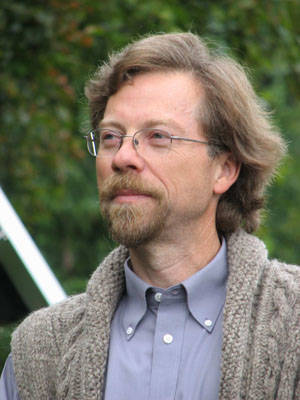When Daniel Lee Henry moved up to Haines in the 80s, he had no intention of embarking on a 32-year project. He moved there to teach, but ultimately ended up deeply immersed in the history and culture of the Chilkat and Chilkoot Tlingits of Southeast Alaska.
Decades of research and interviews with Alaska Native elders has culminated in a book telling the story of John Muir’s complicated relationship with the Tlingit people. “Across the Shaman’s River: John Muir, the Tlingit Stronghold, and the Opening of the North” is the first book to delve into this history and unravel the character of the man who became known as a father of environmentalism.
Henry, a rhetoric and communications professor at the University of Oregon, first read of the Tlingits when he was writing his masters thesis. He was researching the history of land use conflict when he came across a passage in John Muir’s “Travels in Alaska” describing a speech Muir had given which converted 1,000 Chilkats to Christianity.
“As a rhetorician, I am particularly interested in the persuasive messages people are exchanging,” Henry said.
Interest piqued, he began to interview Alaska Native elders about the mass conversion when he moved to Southeast Alaska. One of Henry’s longest interview relationships was with Austin Hammond, who was a leader of the Chilkoot people and whose family is in charge of keeping the story of John Muir and the Tlingit people.
“I was kind of young and impetuous, and didn’t know a lot about the culture, so I came off asking right away ‘what can you tell me about John Muir and the Tlingits of this area?’” Henry said.
Hammond refused to talk to him that day, telling him to “come back tomorrow.” So Henry did, bringing a cameraman and crew to audiotape the interview. Hammond stood up and proceeded to speak for four hours. He talked about the story of the Great Flood, creation stories, and migration stories. Finally, exhausted, he collapsed in his chair.
When Henry asked again about John Muir, Hammond said, “I’m all out of questions for today. Come back tomorrow.”
Henry came back the next day and the next, listening to Hammond’s stories for years.
“He was always very forthcoming with the information but I think he wanted me to really understand the context before he told me the story of Muir and the Tlingit people,” Henry said.
Hammond passed away before he could tell John Muir’s story. Undeterred, Henry sought out Hammond’s niece, Sally Burratin. An elder living in Klukwan, Burratin became a scribe for Hammond’s clan when she was very young. As a “memory keeper,” she was able to tell Henry the story of John Muir exactly as she had heard it from Hammond himself.
“Across the Shaman’s River” tells this story in detail, following Muir’s relationship with the Tlingit people as it shifted from racist to respectful, and sometimes back again. Henry described Muir as normally “having a halo,” known for his environmentalist efforts. His books shows Muir instead “as a human being with all his faults and strengths.”
Henry was open about the sensitive nature of his subject matter.
“I’m looking at how white men coming up to Southeast Alaska were talking to Tlingit people and that alone is a touchy topic because you’re dealing with colonialism, colonial rhetoric. This is a story very much about colonial efforts,” he said.
One of the most surprising, and troubling, things that he learned while researching, Henry said, was John Muir’s pivotal role in kicking off the Klondike Gold Rush. After building a relationship of mutual respect with the Chilkats and Chilkoots, Muir went on to write an article for a San Francisco newspaper saying, “the hostiles have been mollified and the hills are now open for prospectors to make it their own.”
Muir went on to give four speeches in Portland, Oregon, which galvanized the local gold-seekers. Before he had even finished his speeches, Henry said, people were running out of the buildings to go to Alaska. His speeches started the slow but exponential increase of prospectors traveling over the pass to the Klondike until it reached 40,000 people in 1898.
“Generally he’s characterized as the saintly old environmentalist, father of directing conservation, national parks… But there was a racist element to this,” Henry said.
While he was writing the book, he took pains to avoid falling into the same pitfalls as Muir by working with Alaska Native elders at every step. He checked with them first that he was even supposed to be telling this story at all. But since it’s a story about non-Native people as well as Alaska Native people, and not a clan story, the elders gave him the go-ahead.
“I had to have a lot of humility,” he said.
While Henry’s book explores the communication style and persuasion of John Muir, it looks at Tlingit speakers as persuaders, too. Henry compared Tlingit rhetoric from 200-year-old testimonies and found striking similarities with the rhetorical guidelines laid out by ancient Greece’s preeminent philosopher, Aristotle.
As a rhetorician, one of Henry’s main interests is helping people find their voice. He founded the Alaska Native Oratory Society in 2002 when he realized that his students from Alaska Native villages weren’t learning oral traditions and had trouble speaking outside of their hometowns. Part of his goal in including Tlingit rhetoric in “Across the Shaman’s River” was to target young Alaska Native readers and to show them the powerful orators of their heritage.
“(The Tlingits) are great orators. They are powerful people who chose not to use violence, especially later on; they used oratory,” Henry said. “This (story) is one of the rare moments in American history where a Native American area is opened up to white settlement but people are not shuffled off to a reservation, a treaty is not signed, and not a single shot was fired.”
• Jack Scholz is a freelance writer living in Juneau.

